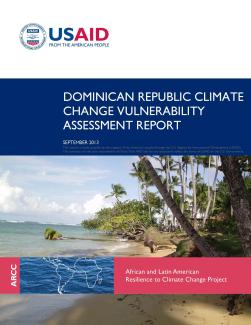The U.S. Agency for International Development (USAID)/African and Latin American Resilience to Climate Change (ARCC) Project conducted the Dominican Republic Climate Change Vulnerability Assessment (DR VA) from December 2012 to May 2013 in response to requests from the USAID/Latin America and Caribbean Bureau and USAID/Dominican Republic. The assessment seeks to improve understanding of climate change impacts on watersheds and coastal resources, and the people dependent on them, in four climate-sensitive targeted hotspots. The methodology for the integrated assessment is multi-scalar and multi-locational (it focuses on four climate-sensitive hotspots — urban and coastal — encompassing Punta Cana/Bávaro; Yaque del Norte [Montecristi/Santiago]; Bajo Yuna [Samaná Bay and Peninsula]; and Santo Domingo). Its organizational structure follows the major components of the widely accepted proposition that vulnerability is a function of three things: exposure to a stress (in this case climatic); the sensitivity of a community, livelihood, or natural system to that stress; and their adaptive capacity to recover from the impacts of that exposure. The most vulnerable communities and households are those with high exposure, high sensitivity, and low adaptive capacity. To assess these factors, climate, watershed, marine and coastal resources, and institutional analyses were conducted in the targeted hotspots.
(7.29 MB)

